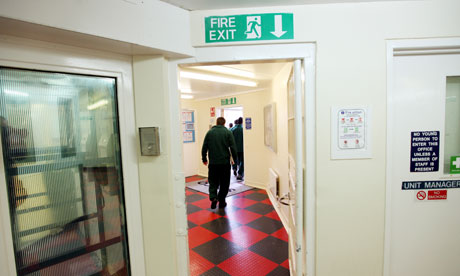Huge increase in use of force at privately run young offender institution
Nine-fold increase in use of force at Ashfield young offender institution only partly accounted for by rise in inmate numbers
Ashfield young offender institution, where there has been a nine-fold rise in the use of force in the past year. Photograph: Graeme Robertson
A huge increase in the use of force to restrain teenage boys at a privately run young offender institution has been sharply criticised by the chief inspector of prisons.
Nick Hardwick says the nine-fold rise in the use of force in the past year at the Serco-run Ashfield young offender institution from an average of 17 times a month to 150 times a month is "extremely high".
The chief inspector has warned the private prison managers at Ashfield, near Bristol, that force must only be used as a last resort where there is an immediate risk to life or limb and not simply to obtain compliance with staff instructions.
But when the prison inspectors went into Ashfield last October they found that more than 40% of the teenage inmates had been restrained and the most frequent reason given in five out of the six preceding months was "failure to obey staff instructions".
Penal reformers said the disclosure has "chilling echoes" of the death of 15-year-old Gareth Myatt, who died while being restrained at a Northamptonshire young offender institution in 2004.
The inspection report on Ashfield published on Friday also says there are serious problems with the late delivery of offenders from court despite a new private escort company, GeoAmey, with inmates delivered from court to Ashfield on one recent occasion between 11pm and 3am.
All new arrivals were also strip-searched even though few items of contraband were ever found. The inspectors say this practice should stop.
Ashfield opened in 1999 on the site of the former Pucklechurch remand centre as the first privately run young offender institution but was repeatedly hit by disturbances. In 2003, the director-general of the prison service described it as the worst prison in Britain and most of the teenagers were withdrawn.
Serco has been running the jail since 2005 and it received a glowing inspection report in 2010 but was only half-full at the time.
The prison inspectors say that Ashfield is now being run at or near its capacity of 380 teenage boys but the staff show a lack of confidence when it comes to dealing with poor behaviour.
The report says the sharp rise in the use of force partly reflected the 50% rise in the population and claims of better recording but most incidents happened when young people were moving to activities.
"In five out of the six preceding months, failure to obey staff instructions was frequently recorded as the issue leading to the use of force. Managers assured us that this analysis was not a true reflection of the main reason for the use of force and that in most instances it had actually been used to prevent escalations of altercations between young people."
But the inspectors make clear that using force to restrain the inmates must never be done simply to ensure they obeyed staff instructions.
Hardwick said: "It is of some concern that some important recommendations in relation to safety have not been met and young people report feeling less safe and less well supported.
"Following the contraction in the number of establishments for children and young people under 18, it is likely that the current situation, operating at or near full capacity, will continue," he said. "The need to ensure safeguarding and behaviour management procedures are operating well will be of greater importance than ever."
Michael Spurr, chief executive officer of the National Offender Management Service, said he accepted that further work needed to be done to create a safer environment.
But Frances Crook of the Howard League for Penal Reform said it had "chilling echoes" of the death of Myatt: "Important safety issues have not been met and there were many incidents of strip-searching children unnecessarily. It was not so long ago that this prison was so unsafe that unprecedented emergency measures were implemented and prisoners were withdrawn as it was likely that the management would lose control of the prison," she said.
"Only three years ago the institution recorded more than 600 attacks on inmates in one year – the highest number of every jail, including adults, in the country. This jail has a history of failing children and the public."


No comments:
Post a Comment